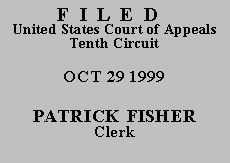

| UNITED STATES OF AMERICA,
vs.
ROBERT L. JOHNSON |
|
On November 13, 1995, Mr. Johnson filed a § 2241 petition seeking habeas relief in the Northern District of Texas. On August 15, 1996, the district court dismissed the petition without prejudice because it should have been filed in the sentencing court and brought under § 2255. The Antiterrorism and Effective Death Penalty Act (AEDPA) became effective April 24, 1996. AEDPA imposed a one-year limitation on § 2255 petitions from "the date on which the judgment of conviction becomes final." 28 U.S.C. § 2255(1). Mr. Johnson subsequently filed a § 2255 motion in the Northern District of Oklahoma on March 24, 1999.
In United States v. Simmonds, 111 F.3d 737, 746 (10th Cir. 1997), this court held that "prisoners whose convictions became final on or before April 24, 1996 must file their § 2255 motions before April 24, 1997." Mr. Johnson's conviction became final ten days after judgment was entered at resentencing in August 1995 and the time for a direct appeal expired. Fed. R. App. Proc. 4(b)(1)(A)(i); see also Griffith v. Kentucky, 479 U.S. 314, 321 n.6 (1987). Thus, his § 2255 claim was time-barred as of April 24, 1997.
Mr. Johnson argues that his original § 2241 petition filed in the Northern District of Texas should be construed as a § 2255 motion and, since he filed before the effective date of AEDPA, the one-year limitation should be inapplicable. We are unpersuaded. Even if we construe the § 2241 petition as one arising under § 2255, the fact remains that it was dismissed. Filing a habeas petition in the wrong venue does not estop the application of AEDPA, even if the original petition was dismissed without prejudice.
Mr. Johnson also argues that the Texas court erred by not transferring his claim to the Northern District of Oklahoma. We disagree. The Texas court was under no duty to transfer the petition, particularly where Mr. Johnson still had sufficient time in which to file a § 2255 motion even under the new AEDPA guidelines. See Phillips v. Seiter, 173 F.3d 609, 610 (7th Cir. 1999) (district courts have considerable discretion in deciding whether to transfer under 28 U.S.C. § 1631).
We DENY a certificate of appealability and DISMISS the appeal.
Entered for the Court
Paul J. Kelly, Jr.
Circuit Judge
*. This order and judgment is not binding precedent, except under the doctrines of law of the case, res judicata, and collateral estoppel. This court generally disfavors the citation of orders and judgments; nevertheless, an order and judgment may be cited under the terms and conditions of 10th Cir. R. 36.3.
**. After examining the briefs and the appellate record, this three-judge panel has determined unanimously that oral argument would not be of material assistance in the determination of this appeal. See Fed. R. App. P. 34(a); 10th Cir. R. 34.1 (G). The cause is therefore ordered submitted without oral argument.